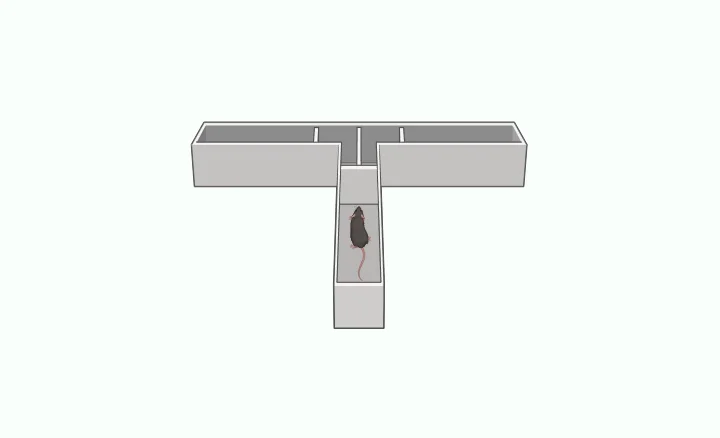

The T maze is a sophisticated apparatus used by scientists to investigate the cognitive functions of rodents. Its simple T-shaped design offers a powerful means to explore various aspects of animal behavior, particularly in the context of neurological research. This article by ConductScience will show the intricacies of the T maze and its applications in cognitive research, explaining how this tool helps scientists understand the complexities of rodent brains, especially in cases involving neurological disorders.
Rodents, being naturally inquisitive, provide an excellent model for studying brain function through their exploratory behavior in the T maze. This maze enables researchers to examine different brain regions, such as the hippocampus, septum, basal forebrain, and prefrontal cortex, by observing how these animals navigate and explore new environments.
Figure: T Maze
The T maze is used for understanding cognitive abilities, especially learning and memory. It’s not just for basic research; it’s also used to study how disorders, conditions, and drugs affect cognitive function.
In spatial memory testing, the T maze shows its power with rewarded alternation. First, the mouse gets to know the maze. Then, rewards are put at the ends of both arms, but only one arm is open at first. The mouse starts at the bottom and goes to the open arm for a reward. Later, the other arm opens, giving the mouse a choice. If it picks the new arm, it gets another reward, showing rewarded alternation [1].
Through repeated trials, researchers expect to observe a decreased tendency for the animals to re-enter a previously visited arm. Parameters such as the percentage of alternation (number of turns in each goal arm) and total trial duration are recorded. This test serves to quantify cognitive deficits in transgenic mouse strains and to evaluate the effects of novel chemical compounds on cognition.
Conversely, spontaneous alternation shows spatial learning in the T maze setup. Unlike spatial memory testing, the mouse enters the maze without prior familiarization. Both arms host food rewards from the onset, prompting the mouse to choose its path. Upon revisiting the base, the mouse tends to opt for the alternate arm, indicative of spatial learning and memory retention [2].

Figure: Mouse placed in one arm with food. Image from https://togotv.dbcls.jp/en/togopic.2021.108.html
Spatial memory, the ability to remember and navigate through space, was investigated in twenty adult male Sprague-Dawley rats using the T maze test. The T maze, constructed of black Plexiglas with two long arms (60 cm × 10 cm) and one short arm (30 cm × 10 cm), served as the experimental apparatus [3].
During the habituation phase, rats were allowed free exploration of the T maze for three consecutive days. Subsequently, spatial learning trials were conducted, wherein one of the long arms contained a hidden food reward while the other long arm remained empty. Rats were trained to find the food reward by relying on spatial cues within the maze.
Following training, probe trials were carried out where spatial cues within the maze were altered or removed to assess the rats’ reliance on spatial memory for navigation. The number of correct and incorrect arm choices, as well as the latency to reach the food reward, were recorded and analyzed using appropriate statistical methods.
Preliminary results indicated that rats trained in the T maze exhibited a significant preference for the correct arm compared to chance levels, suggesting successful spatial learning. Additionally, probe trials revealed that rats relied heavily on spatial cues for navigation, as evidenced by impaired performance when cues were altered or removed.
Overall, this experiment demonstrated the utility of the T maze in investigating cognitive constructs such as spatial memory in rodents. Further research utilizing this paradigm may contribute to our understanding of the neural basis of spatial cognition.
Noteworthy studies underscore the utility of the T maze in unraveling cognitive phenomena. Chapman et al. (1999) explored Alzheimer’s disease using a transgenic mouse model, revealing age-related impairments in learning and memory through T maze trials [4]. These findings shed light on the progressive nature of cognitive decline in Alzheimer’s disease. Additionally, Deacon and Rawlins (2006) provided insights into the nuances of T-maze alternation, emphasizing its relevance in studying hippocampal function and spatial memory [5].
While the T maze remains a cornerstone in cognitive research, variations such as the multiple T maze offer increased complexity for nuanced investigations. Analogous mazes, including the Y maze, Barnes maze, and Morris water maze, augment the arsenal of tools available to neuroscientists, each offering unique perspectives on cognitive function [6].
Figure: Mouse placed in one arm with food. Image from https://togotv.dbcls.jp/en/togopic.2021.108.html
The T maze test offers researchers a window into the complex workings of spatial memory and navigation in rodents. Through its simple yet effective design, this paradigm has provided invaluable insights into the neural mechanisms underlying these cognitive processes.
By capitalizing on rodents’ natural inclination to explore new environments, the T maze has allowed scientists to unravel the interplay between various brain regions involved in spatial cognition.

Vanja works as the Social Media and Academic Program Manager at Conduct Science. With a Bachelor's degree in Molecular Biology and Physiology and a Master's degree in Human Molecular Biology, Vanja is dedicated to sharing scientific knowledge on social media platforms. Additionally, Vanja provides direct support to the editorial board at Conduct Science Academic Publishing House.
